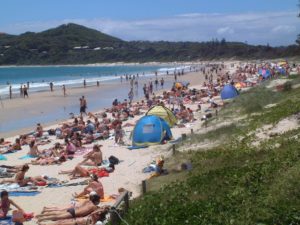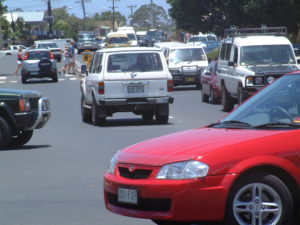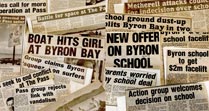
BYRON Bay is my home, I just don’t live there any more.
Pam and I sold our Suffolk Park home two years ago for two reasons – firstly to get some money in the bank for our retirement years and secondly I was sick of being angry over what the Bay had become and where it was going.
I didn’t want to end up hating the town I love and which is still very much part of my very core.
Byron Bay today is not the chilled out, laid-back cool place it pretends to be – and what the cosmics of the world perhaps think it is. And it hasn’t been for many years.
I lived and worked in the town for 35 years and I am there on average three times a week and I can tell you that the ‘love and peace brother’ vibe has long since gone.
While Byron Bay, with its amazing natural assets, still has a special ‘feel’, unhappily, for me at least, it has become an overcrowded, overpriced and in some people’s eyes, an over-rated, money-grubbing theme park being killed, mostly, by cars – and of course its own popularity.
I won’t say the town is being ‘loved to death’ because that would indicate the majority of the 2.5 million annual visitors actually care about the place.
Many do of course, but it’s fairly obvious, through their behaviour – think littering, anti-social behaviour, illegal camping and left-my-brains-at-home no respect attitude – that there are vast hordes who don’t.
For some, the laws of the land cease to exist when they come into the Byron Shire. They do what they want, park where they want, drive how they want, camp where they want, drink where they want and as an excuse for their behaviour use the ‘but it’s Byron Bay’ line.
The anger on show in comments on Byron Bay social media sites from locals relating to those behaviours, lack of core infrastructure, tourist numbers, the cost of housing/renting, crowded surf breaks and other issues is real.
The number of disillusioned long-time residents bailing from the town, sadly, just continues to grow.
Aiding and abetting the strangulation of The Bay are cashed-up big city investors buying up family homes that they turn into Air B & Bs depriving locals of an affordable place to live and which are destroying (have destroyed?) the once close-knit social fabric of neighbourhoods.
Byron Bay has come from being a shipping port, a commercial centre and a meatworks town to the international tourist icon that it is today.
Indeed, it was a meatworks town when I came to Byron Bay in 1983 with my wife and then two-year-old son as escapees from Sydney.
We had never previously visited the town and it was only by chance that we ended up there after buying a café we saw advertised in a Sydney paper.
Within weeks of moving into our café (where today’s Bay Leaf is located) Byron Bay’s major employer, the meatworks located at Belongil Beach was closed by the relatively new owners, Elders-IXL, throwing 350 people out of work.
That closure sent shockwaves through the town – including us – and just about everyone living in the town at the time knew someone who had lost their job, leaving many families facing uncertain futures because there just weren’t any jobs.
It was a town which had seen logging, sandmining, whaling and butter and smallgoods manufacturing come and go with tourism playing only a minor, seasonal role in the local economy.
Our business neighbour, barber Robert Carroll, who had operated in the town for many years, put it bluntly to me, ‘This town is f…..d mate.’
The late barber was on to something there, but I’m sure it hasn’t been ‘f….d’ the way he would have imagined it would be.
He was thinking more of a slow, lingering death with tumbleweeds blowing down Jonson Street.
That of course didn’t happen.
Getting over the initial shock of the meatworks closure, Byron Bay’s civic, business and community leaders determined that tourism was going to be the saviour of the town.
It took some years, but it obviously worked helped by two major contributing factors – the opening by John Cornell and Delvene Delaney of The Beach Hotel in the early 1990s and their connection with Crocodile Dundee star, Paul Hogan and the completion of the freeway from south-east Queensland making the town easily accessible for thousands of day-trippers.
When we came to Byron Bay we knew hardly anything about the town so we had no preconceived notions about what to expect.
We were looking for a quieter and different lifestyle in a small regional friendly seaside community with a heart – and we absolutely found it. It was a dream.
Parking at the Main Beach car park on our first morning in the town in 1983 and soaking up ‘that’ view across the bay, it was love at first sight.
I vividly recall turning to Pam all those years ago and saying. ‘Shit! This will do me.’
Happily, that captivating view remains – as must the car park – but the soul of the town I knew in those wonderful early years is for me, today, unrecognisable.
Can Byron Bay reclaim some of that lost soul?
Well, putting a limit on tourist numbers, banning cars in the CBD, clamping down on Air B & Bs and banning any future residential development might help.
But we all know none of that will happen.
Popularity has its price. There is no going back.
